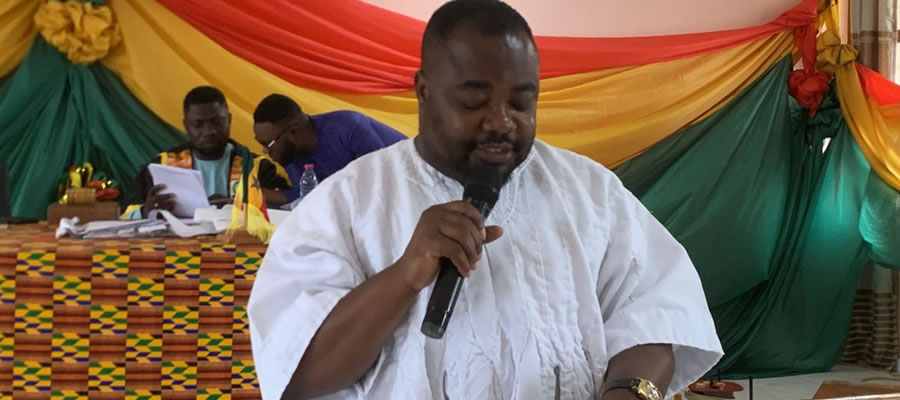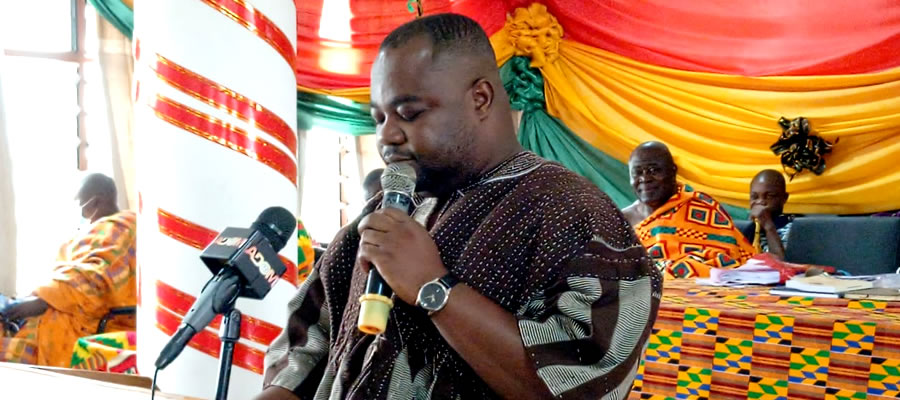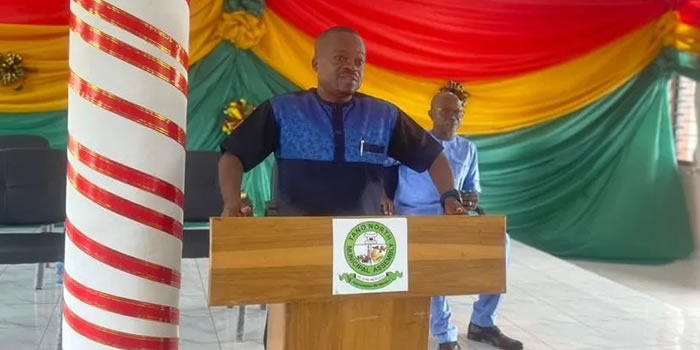

Water and Sanitation
Water
Access to safe water is a pre-requisite for a healthy population. The availability of water systems, their functionality and the quality of water are necessary for the provision of safe water for drinking and domestic purposes. Four main water systems exist in the Municipal. They are;
- Conventional water supply system from Ghana Water Company – Abesim (three communities)
- Small towns water supply system (3 communities-Duayaw Nkwanta, Adrobaa and Bomaa with forty five (45) stand pipes)
- Limited mechanization(eight communities with eighteen (18) facilities)
- Hand pumps (seventy one (71) communities with one hundred and sixteen (116)facilities)
N/B: Some of the communities that use other systems use hand pumps as well to supplement what they have.
Out of the 116 facilities 75 are functioning, 12 are optimally functioning and 27 are not functioning at all. One of the Small Towns Water Supply Systems was not functioning, i.e, Bomaa, but now it has been restored by Safe Water (NGO). The rest of the systems are all functioning. The higher number of the non - functioning facilities is largely attributed to several factors such as, nonpayment of levies by households and individuals towards operation and maintenance of the facilities. Secondly, interference of traditional leaders and other opinion leaders also accounts for that. Again, lack of capacity building for the WATSAN committees in carrying out their duties is also a factor.
Community Ownership and Maintenance
The water and sanitation facilities in the communities belong to the communities and they are responsible for their management (operation and maintenance). The communities decide on how they want to manage their own water and sanitation facilities. The small towns water supply systems are managed by water and sanitation management teams (WSMT) whereas limited mechanizations and the hand pumps are managed by water and sanitation committees (WATSANS).
The members of the WATSANs and WSMTs are elected by the communities and the DWST facilitate the process. In Tano North Municipal, there are two WSMTs and 61 WATSANs in 71 communities. Out of the 61 committees, 49 are functioning and the rest are not functioning due to the factors enumerated above and other factors such as lack of political will and unable to cope with insults from some of the community members among others. However, there are mechanisms in place to revive the weak WATSANs and WSMTs and establish the new ones.
Maintenance and Repairs
Once the facility is handed over to the community, it becomes their property and they are responsible for its operation and maintenance. The policy is that, the facility should not break down for more than three days without repairing it. That is the reason why the WATSANs must be active in their operation so as to mobilize funds for operation and maintenance. Every WATSAN should have bank accounts with money it all the time for any eventualities. They should also have a care taker who will be responsible for checking minor faults and maintain it. There are also three trained area mechanics who do major repairs for a fee since they are not assembly workers. The community is responsible for all payment of bills concerning their facility.
Waste Management
Solid Waste Management
The Tano North generate solid waste form the following underlisted sources: households, lorry station, shops, markets, schools, offices, slaughter slab, health facilities, guest houses, public eating places etc. The collection, transport and management of solid waste are done by the Environmental Health Department and Zoomlion a private solid waste management company.
The 2010 PHC depicts shows that 57.1 percent of households dispose of solid waste at public dump in open spaces. Households that dispose of their solid waste at public dump in a container form 16.1 percent. Indiscriminate dumping of solid waste is common among 10 percent of the households.
Public dumping in open spaces are common among urban (54.8%) and rural (59.9%) households. Households in urban areas (21.3%) are more likely than those in rural areas (9.8%) to dump their solid waste in containers. Contrariwise, households in rural areas (15.7%) are more likely than those in urban areas (5.3%) to dump their solid waste indiscriminately.
The Assembly has designated refuse dumps where community members dispose of refuse. Even though places of this nature have been provided people go beyond to create unapproved refuse dumps because of distance or other reasons resulting in indiscriminate dumping. The table below shows how refuse are disposed-off at approved and unapproved disposal site.
There is the need for the assembly to provide skip containers and bins at vantage points in the Municipal as the table above indicates that the unapproved sites outnumbered approved sites.
Each of the five (5) Town and Area Councils has their separate final disposal sites. The methods in use are not the best and there is the need to improve upon them in relation to the national sanitation policy.
Liquid Waste
Liquid waste management involves the dislodging, collection, conveyance, treatment and disposal of the liquid waste.It also includes storm water drainage and silage conveyance in the Municipal. Liquid waste collection, particularly sewage is woefully inadequate.
Liquid wastes in the Municipal are mainly thrown onto compound (45.2%) and onto the street (43.8%). This phenomenon is irrespective of locality of residence of the household, except that more households in urban areas (50.0%) throw their liquid waste onto the street while more households in rural areas (57.9%) throw their liquid waste onto the compound. (2010 PHC)
Currently, the Municipal has no cesspool emptier to dislodge liquid waste from cesspits, however, it relies on the neighbouring Municipals. Even with that the Municipal has no final place to offload the slugde. There is therefore the need to encourage the construction of household latrine to minimize the use of public toilets as it posts a lot of health hazards such as flies breeding, emission of offensive odour and so on.
Four main types of toilet facilities can be identified in the Municipal. These include water closet (W.C), K.V.I.P, Aqua Privy (septic Tank), and pit latrines. The table below shows the number of public toilets.
According to 2010 Population and Housing Census Report, Public toilet is used by 49.4 percent of households in the Municipal. About one-third (33.1%) of the households, use pit latrine while 6.8 percent also use KVIP. Only 5.5 percent of households in the Municipal use WC toilet facility. The proportion of households in rural areas(39.9%) who use pit latrine is relatively high compared those in urban areas (27.5%).
In addition, a few number of inhabitants have household toilets. There is the need to encourage and enforce more people to include toilets in their building plans to reduce the pressure on the public toilets.
Drains play a major role in addressing environmental sanitation problems as it helps in directing runoff water which could serve as flood or storm water in the community. Primary, secondary and tertiary drains exist in the Municipals.
Duayaw Nkwanta Township has number of drains constructed and in good shape. Areas that have drains include:
• Camposo road 400m drain constructed on opposites sides
• Nsesereso 200m drain constructed
• Taxi rank to police station 450m drain constructed on opposites sides
• D/Nkwanta – Techimantia road 100m drain constructed on both sides
• Timber road 50m one side drain constructed
Zongo and Abaase have 65m and 100m drain unconstructed. Open space mode of silage disposal is dominant in the Municipal. There is the need to construct all categories of drains in the Municipal.
Apart from Bomaa Township that has some concrete drains along the Bomaa-Tepa truck road, other parts of Bomaa do not have proper drains constructed. Most of the drains in these communities are natural. Similar drains could be seen in Asukese, Tanokrom and Subonpang and due to the steep sloppy nature of the land in these areas it is easy to find tertiary gullies eroded drain expanding to form ravine likely to serve as a harborage for breeding mosquitoes.
Tanoso has two main gutters by the sides on the main road. Two storm drains have recently been constructed. This is inadequate since waste water from various house are disposed off indiscriminately.
Susuanso has two main gutters by the sides of the main road that divides the town. There are no gutters within the lanes to contain storm and waste water. Afrisipa has no gutters by the sides of the main road. A storm drain has recently been constructed along the left side of the main road. Both sides of the road needs storm drains to cater for storm water.
Water Security
The availability and accessibility to potable water is of great concern to the household members in the Municipal because not only is water a necessity but also a source of life. On the contrary, water can also be the source of diseases such as cholera, typhoid, dysentery and other feco-oral diseases especially among children. Accessibility also affects productivity especially among women and children who are the traditional water bearers.
Water is very essential for human survival. Households, companies, offices among other set ups need water in one way or the other to effectively run their everyday activities. Thus, its availability and quality is essential for convenience and health purposes. According to the Population and Housing Census Report 2010, the main source of drinking water is pipe borne (53.7%), borehole (27.8%) and river/stream (11.6%).
The main source of drinking water for half (50%) and one fifth (23.2%) of households in rural areas are borehole and stream/ river respectively. In Urban areas however, pipe (80.6%) is the main source of drinking water.
The insufficiency of supply also impacts negatively on environmental sustainability where people indiscriminately dig manholes and boreholes in search for water supply.
There is also the use of unhygienic water which could impact on the health and disease condition of people living in the Municipal. In effect, the search for water will affect universal education and hunger situation within the Municipal.
Total number of new drilled bore-holes 22
Total number of completed bore-holes 12
Total number of uncompleted bore-holes 8
Total number of unsuccessfully drilled bore-holes 2
Communities Which Have Qualified For Small Town Water Supply Systems (STWSS)
Drilling and Construction of 4No. Small Town Water Supply Systems (STWSS) in Four Communities to be undertaken by Safewater Network in the Tano North Municipal. Feasibility studies, Needs Assessment and Survey are completed and below are the Communities that were selected to be up lifted from Mechanized Bore-Holes to Small Town Water Supply Systems (STWSS), Bomaa -Asukese, Terchere, Adrobaa and Afrisipakrom. Currently, Bomaa-Asukese project is completed, Adrobaa is on-going.
From the table above, it could be realized that, there are 69 schools and 8 health institutions. From this;
a. 20 schools use pit latrines which is outmoded in the system.
b. 10 schools do not have any toilet facility at all
c. 3 schools have water closet
d. 29 schools have KVIP
e. Out of the 69 schools 32 of them have improved toilet facility.
g. 30 of them have no improved toilet facility
However, some schools and health institution have water closet but since they don’t have water, the system is not being utilized. There is the need to provide water facilities and construct improved toilet facilities to school and health institution.
Date Created : 11/23/2018 4:36:05 AM












 facebook
facebook
 twitter
twitter
 Youtube
Youtube
 +233 593 831 280
+233 593 831 280 0800 430 430
0800 430 430 GPS: GE-231-4383
GPS: GE-231-4383 info@ghanadistricts.com
info@ghanadistricts.com Box GP1044, Accra, Ghana
Box GP1044, Accra, Ghana